Economic Principles and Decision Making Assignment - University Course
VerifiedAdded on 2023/01/19
|9
|1246
|85
Homework Assignment
AI Summary
This economics assignment solution delves into several core economic principles. It begins by examining income elasticity of demand, illustrating how changes in consumer income affect the demand for inferior goods like noodles. The solution then explores the production possibility frontier (PPF), demonstrating the trade-offs and efficient allocation of resources in a simplified model. The assignment continues with the calculation of both accounting and economic profit, highlighting the differences between explicit and implicit costs and their impact on profitability. Finally, the solution addresses negative externalities using the example of vehicle inspections and their role in mitigating environmental and social costs, incorporating a relevant graph to explain the concept. The solution provides comprehensive explanations and calculations for each concept.
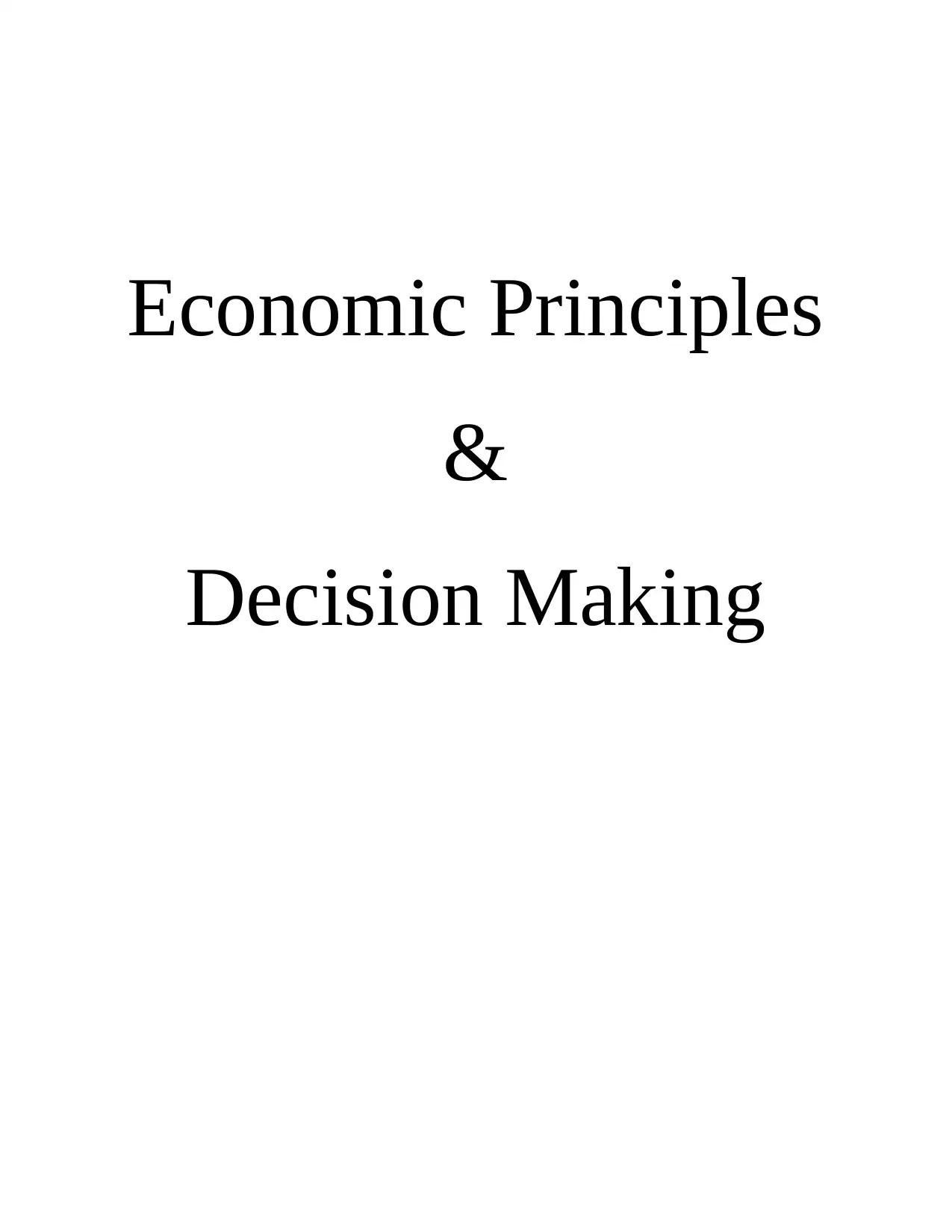
Economic Principles
&
Decision Making
&
Decision Making
Paraphrase This Document
Need a fresh take? Get an instant paraphrase of this document with our AI Paraphraser
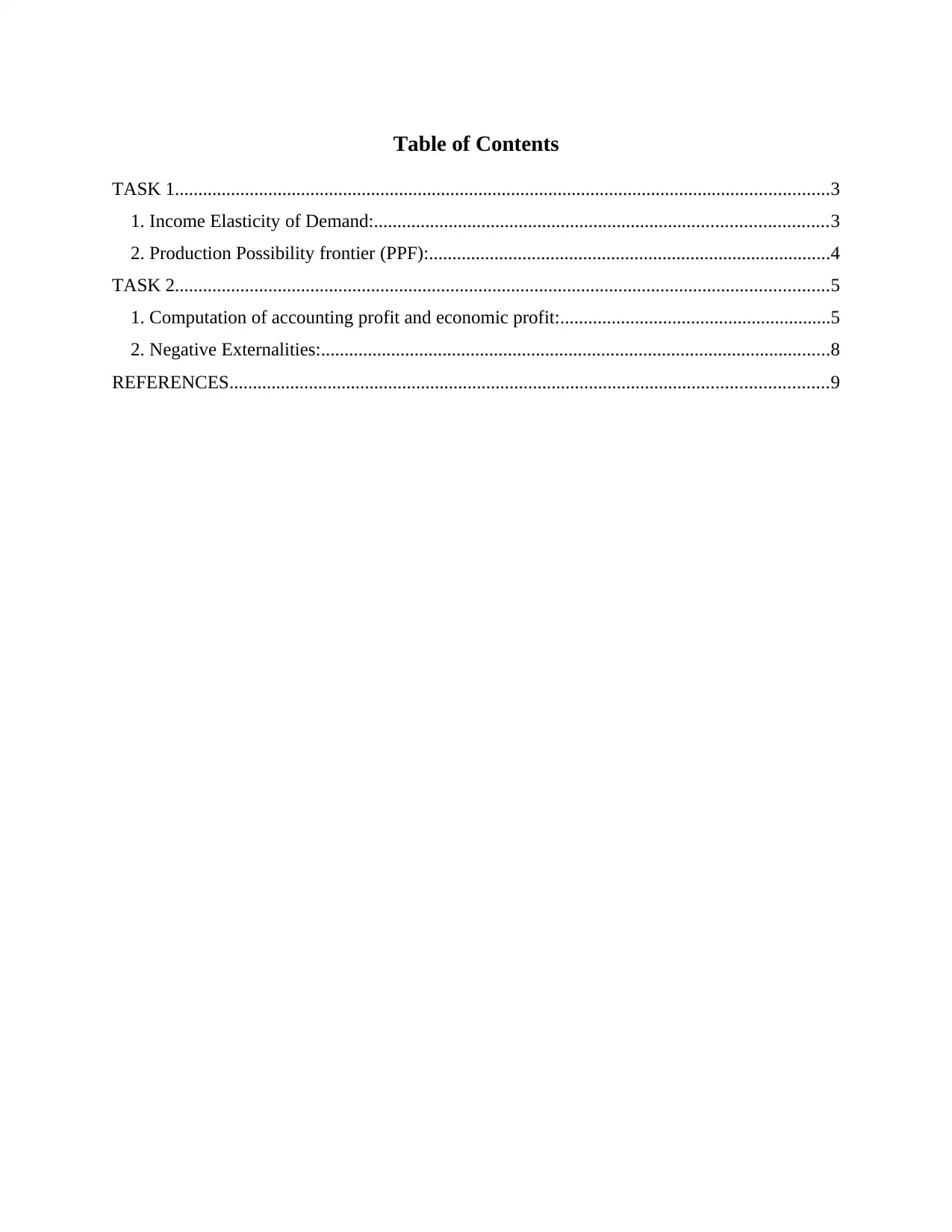
Table of Contents
TASK 1............................................................................................................................................3
1. Income Elasticity of Demand:.................................................................................................3
2. Production Possibility frontier (PPF):......................................................................................4
TASK 2............................................................................................................................................5
1. Computation of accounting profit and economic profit:..........................................................5
2. Negative Externalities:.............................................................................................................8
REFERENCES................................................................................................................................9
TASK 1............................................................................................................................................3
1. Income Elasticity of Demand:.................................................................................................3
2. Production Possibility frontier (PPF):......................................................................................4
TASK 2............................................................................................................................................5
1. Computation of accounting profit and economic profit:..........................................................5
2. Negative Externalities:.............................................................................................................8
REFERENCES................................................................................................................................9
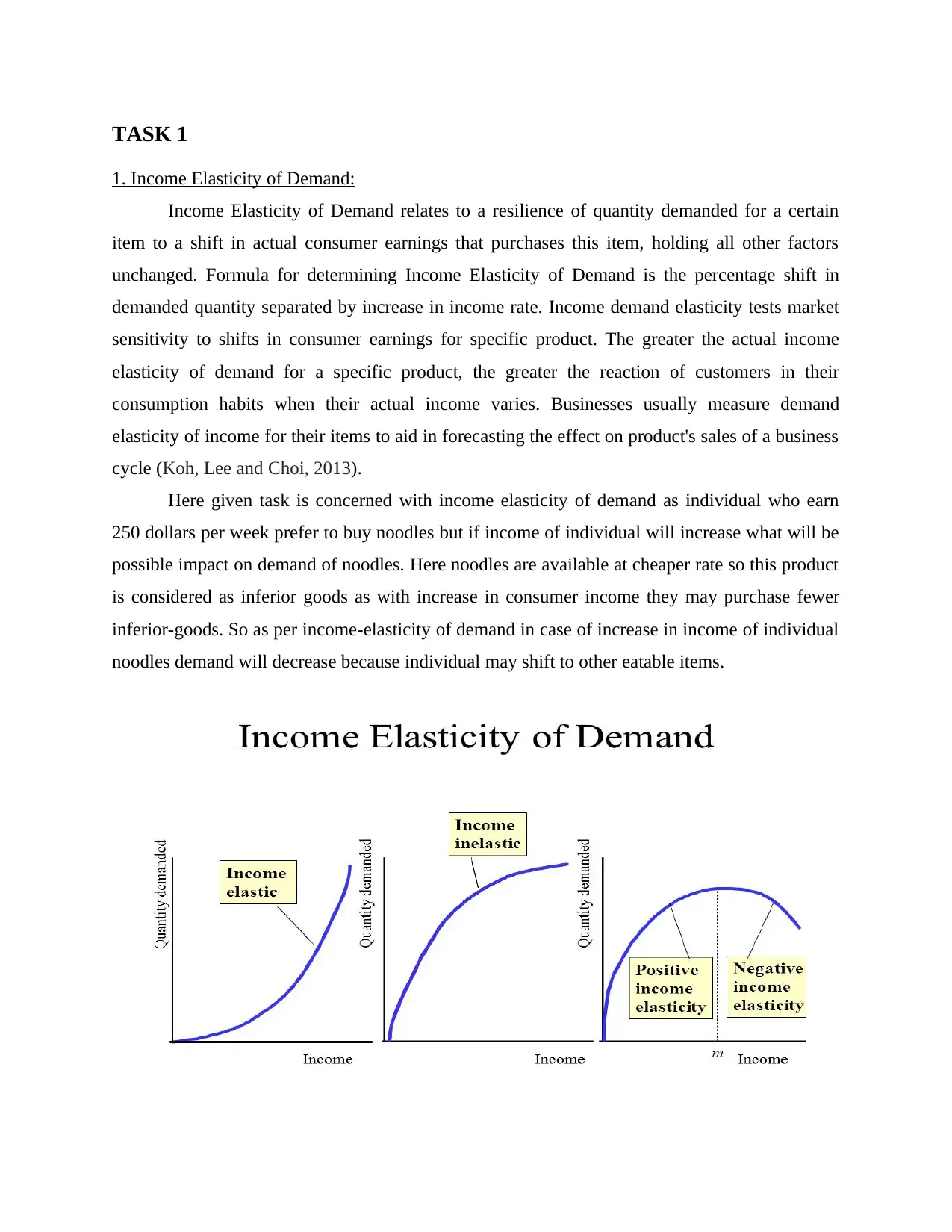
TASK 1
1. Income Elasticity of Demand:
Income Elasticity of Demand relates to a resilience of quantity demanded for a certain
item to a shift in actual consumer earnings that purchases this item, holding all other factors
unchanged. Formula for determining Income Elasticity of Demand is the percentage shift in
demanded quantity separated by increase in income rate. Income demand elasticity tests market
sensitivity to shifts in consumer earnings for specific product. The greater the actual income
elasticity of demand for a specific product, the greater the reaction of customers in their
consumption habits when their actual income varies. Businesses usually measure demand
elasticity of income for their items to aid in forecasting the effect on product's sales of a business
cycle (Koh, Lee and Choi, 2013).
Here given task is concerned with income elasticity of demand as individual who earn
250 dollars per week prefer to buy noodles but if income of individual will increase what will be
possible impact on demand of noodles. Here noodles are available at cheaper rate so this product
is considered as inferior goods as with increase in consumer income they may purchase fewer
inferior-goods. So as per income-elasticity of demand in case of increase in income of individual
noodles demand will decrease because individual may shift to other eatable items.
1. Income Elasticity of Demand:
Income Elasticity of Demand relates to a resilience of quantity demanded for a certain
item to a shift in actual consumer earnings that purchases this item, holding all other factors
unchanged. Formula for determining Income Elasticity of Demand is the percentage shift in
demanded quantity separated by increase in income rate. Income demand elasticity tests market
sensitivity to shifts in consumer earnings for specific product. The greater the actual income
elasticity of demand for a specific product, the greater the reaction of customers in their
consumption habits when their actual income varies. Businesses usually measure demand
elasticity of income for their items to aid in forecasting the effect on product's sales of a business
cycle (Koh, Lee and Choi, 2013).
Here given task is concerned with income elasticity of demand as individual who earn
250 dollars per week prefer to buy noodles but if income of individual will increase what will be
possible impact on demand of noodles. Here noodles are available at cheaper rate so this product
is considered as inferior goods as with increase in consumer income they may purchase fewer
inferior-goods. So as per income-elasticity of demand in case of increase in income of individual
noodles demand will decrease because individual may shift to other eatable items.
⊘ This is a preview!⊘
Do you want full access?
Subscribe today to unlock all pages.

Trusted by 1+ million students worldwide
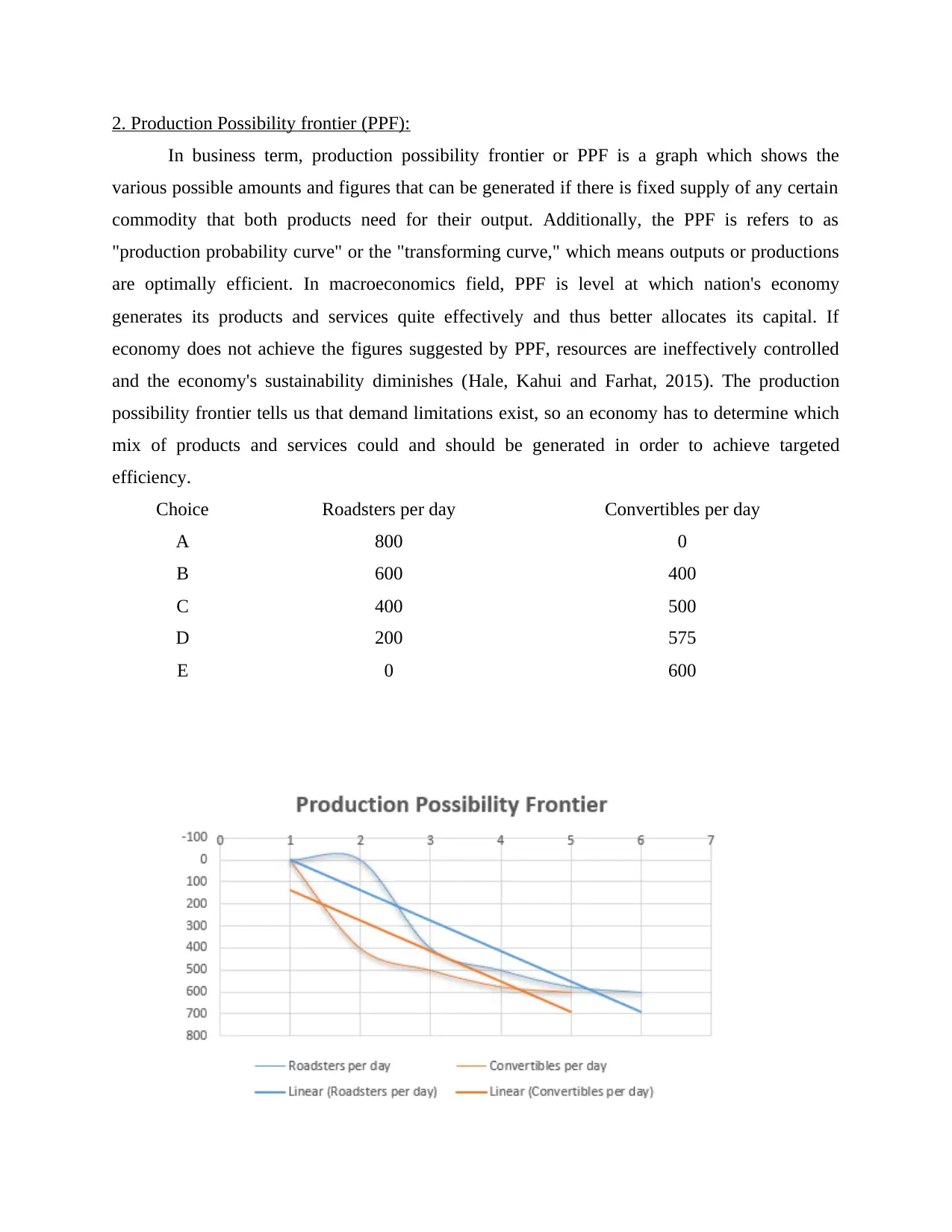
2. Production Possibility frontier (PPF):
In business term, production possibility frontier or PPF is a graph which shows the
various possible amounts and figures that can be generated if there is fixed supply of any certain
commodity that both products need for their output. Additionally, the PPF is refers to as
"production probability curve" or the "transforming curve," which means outputs or productions
are optimally efficient. In macroeconomics field, PPF is level at which nation's economy
generates its products and services quite effectively and thus better allocates its capital. If
economy does not achieve the figures suggested by PPF, resources are ineffectively controlled
and the economy's sustainability diminishes (Hale, Kahui and Farhat, 2015). The production
possibility frontier tells us that demand limitations exist, so an economy has to determine which
mix of products and services could and should be generated in order to achieve targeted
efficiency.
Choice Roadsters per day Convertibles per day
A 800 0
B 600 400
C 400 500
D 200 575
E 0 600
In business term, production possibility frontier or PPF is a graph which shows the
various possible amounts and figures that can be generated if there is fixed supply of any certain
commodity that both products need for their output. Additionally, the PPF is refers to as
"production probability curve" or the "transforming curve," which means outputs or productions
are optimally efficient. In macroeconomics field, PPF is level at which nation's economy
generates its products and services quite effectively and thus better allocates its capital. If
economy does not achieve the figures suggested by PPF, resources are ineffectively controlled
and the economy's sustainability diminishes (Hale, Kahui and Farhat, 2015). The production
possibility frontier tells us that demand limitations exist, so an economy has to determine which
mix of products and services could and should be generated in order to achieve targeted
efficiency.
Choice Roadsters per day Convertibles per day
A 800 0
B 600 400
C 400 500
D 200 575
E 0 600
Paraphrase This Document
Need a fresh take? Get an instant paraphrase of this document with our AI Paraphraser
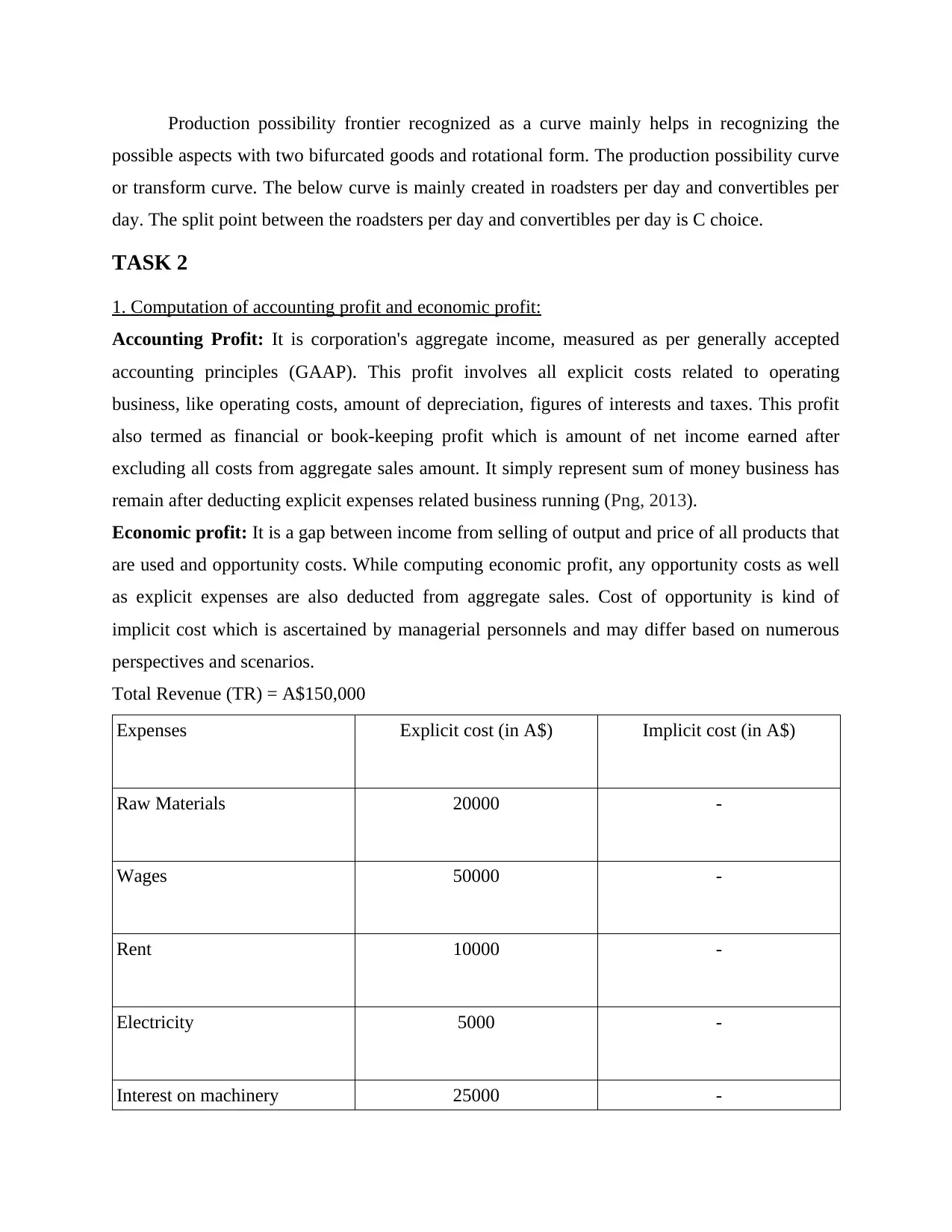
Production possibility frontier recognized as a curve mainly helps in recognizing the
possible aspects with two bifurcated goods and rotational form. The production possibility curve
or transform curve. The below curve is mainly created in roadsters per day and convertibles per
day. The split point between the roadsters per day and convertibles per day is C choice.
TASK 2
1. Computation of accounting profit and economic profit:
Accounting Profit: It is corporation's aggregate income, measured as per generally accepted
accounting principles (GAAP). This profit involves all explicit costs related to operating
business, like operating costs, amount of depreciation, figures of interests and taxes. This profit
also termed as financial or book-keeping profit which is amount of net income earned after
excluding all costs from aggregate sales amount. It simply represent sum of money business has
remain after deducting explicit expenses related business running (Png, 2013).
Economic profit: It is a gap between income from selling of output and price of all products that
are used and opportunity costs. While computing economic profit, any opportunity costs as well
as explicit expenses are also deducted from aggregate sales. Cost of opportunity is kind of
implicit cost which is ascertained by managerial personnels and may differ based on numerous
perspectives and scenarios.
Total Revenue (TR) = A$150,000
Expenses Explicit cost (in A$) Implicit cost (in A$)
Raw Materials 20000 -
Wages 50000 -
Rent 10000 -
Electricity 5000 -
Interest on machinery 25000 -
possible aspects with two bifurcated goods and rotational form. The production possibility curve
or transform curve. The below curve is mainly created in roadsters per day and convertibles per
day. The split point between the roadsters per day and convertibles per day is C choice.
TASK 2
1. Computation of accounting profit and economic profit:
Accounting Profit: It is corporation's aggregate income, measured as per generally accepted
accounting principles (GAAP). This profit involves all explicit costs related to operating
business, like operating costs, amount of depreciation, figures of interests and taxes. This profit
also termed as financial or book-keeping profit which is amount of net income earned after
excluding all costs from aggregate sales amount. It simply represent sum of money business has
remain after deducting explicit expenses related business running (Png, 2013).
Economic profit: It is a gap between income from selling of output and price of all products that
are used and opportunity costs. While computing economic profit, any opportunity costs as well
as explicit expenses are also deducted from aggregate sales. Cost of opportunity is kind of
implicit cost which is ascertained by managerial personnels and may differ based on numerous
perspectives and scenarios.
Total Revenue (TR) = A$150,000
Expenses Explicit cost (in A$) Implicit cost (in A$)
Raw Materials 20000 -
Wages 50000 -
Rent 10000 -
Electricity 5000 -
Interest on machinery 25000 -
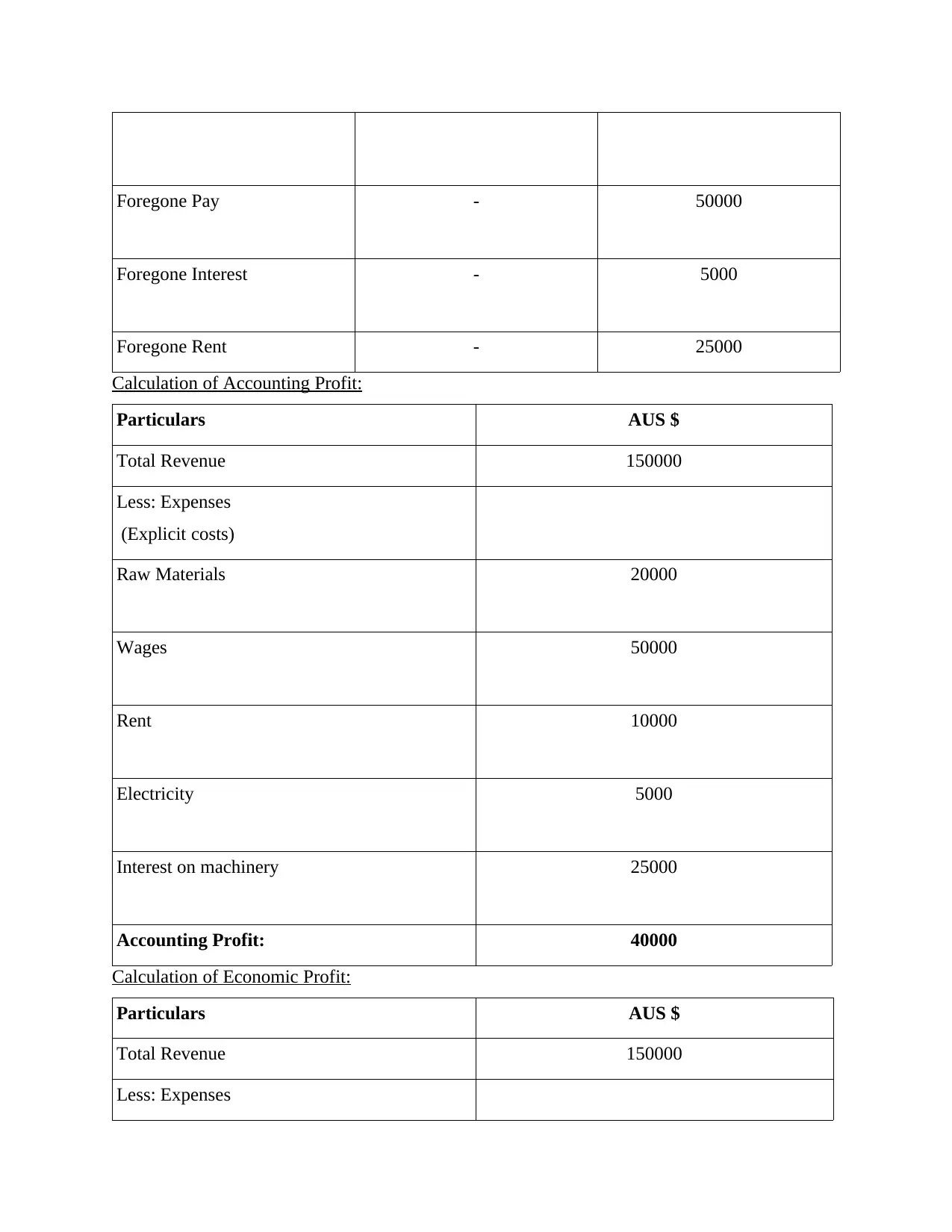
Foregone Pay - 50000
Foregone Interest - 5000
Foregone Rent - 25000
Calculation of Accounting Profit:
Particulars AUS $
Total Revenue 150000
Less: Expenses
(Explicit costs)
Raw Materials 20000
Wages 50000
Rent 10000
Electricity 5000
Interest on machinery 25000
Accounting Profit: 40000
Calculation of Economic Profit:
Particulars AUS $
Total Revenue 150000
Less: Expenses
Foregone Interest - 5000
Foregone Rent - 25000
Calculation of Accounting Profit:
Particulars AUS $
Total Revenue 150000
Less: Expenses
(Explicit costs)
Raw Materials 20000
Wages 50000
Rent 10000
Electricity 5000
Interest on machinery 25000
Accounting Profit: 40000
Calculation of Economic Profit:
Particulars AUS $
Total Revenue 150000
Less: Expenses
⊘ This is a preview!⊘
Do you want full access?
Subscribe today to unlock all pages.

Trusted by 1+ million students worldwide
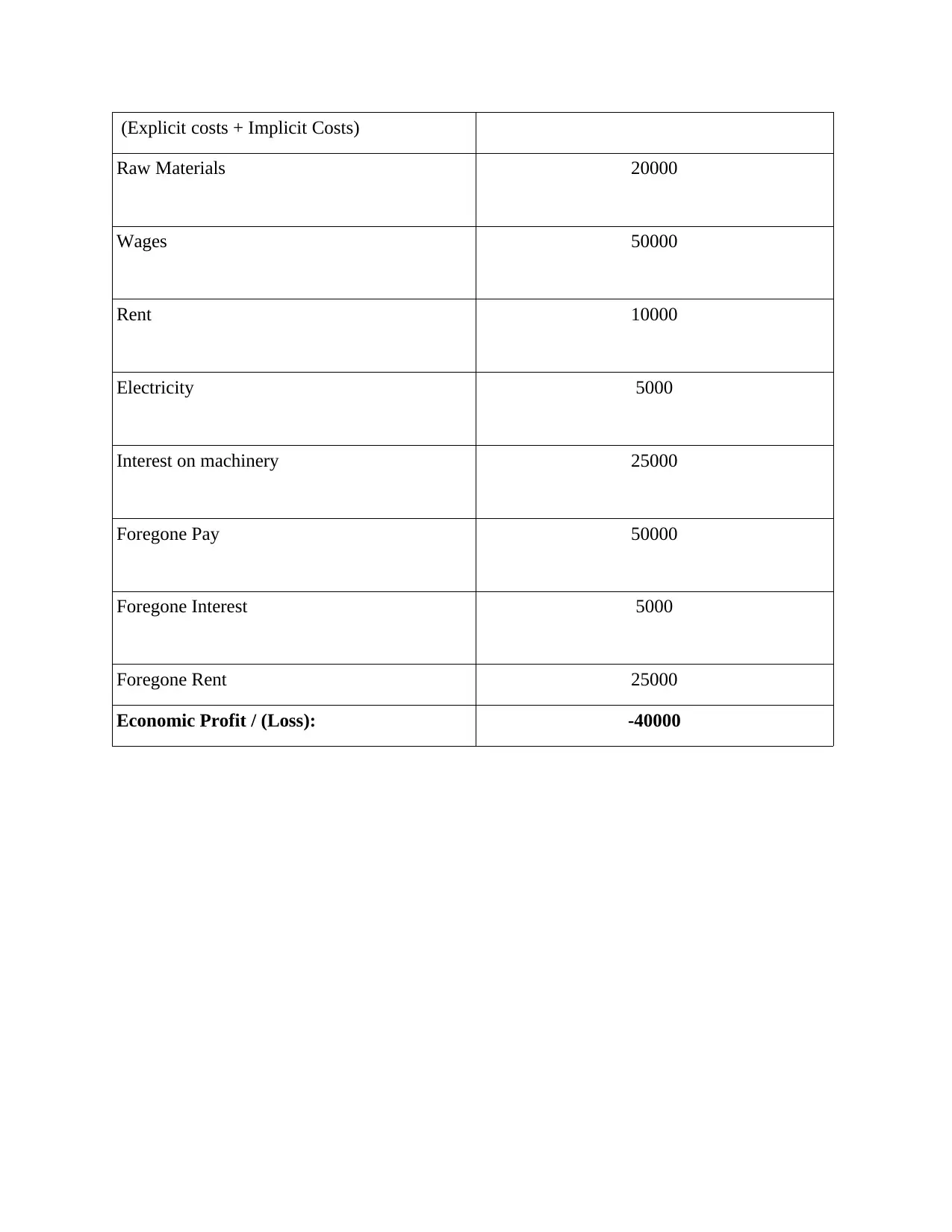
(Explicit costs + Implicit Costs)
Raw Materials 20000
Wages 50000
Rent 10000
Electricity 5000
Interest on machinery 25000
Foregone Pay 50000
Foregone Interest 5000
Foregone Rent 25000
Economic Profit / (Loss): -40000
Raw Materials 20000
Wages 50000
Rent 10000
Electricity 5000
Interest on machinery 25000
Foregone Pay 50000
Foregone Interest 5000
Foregone Rent 25000
Economic Profit / (Loss): -40000
Paraphrase This Document
Need a fresh take? Get an instant paraphrase of this document with our AI Paraphraser
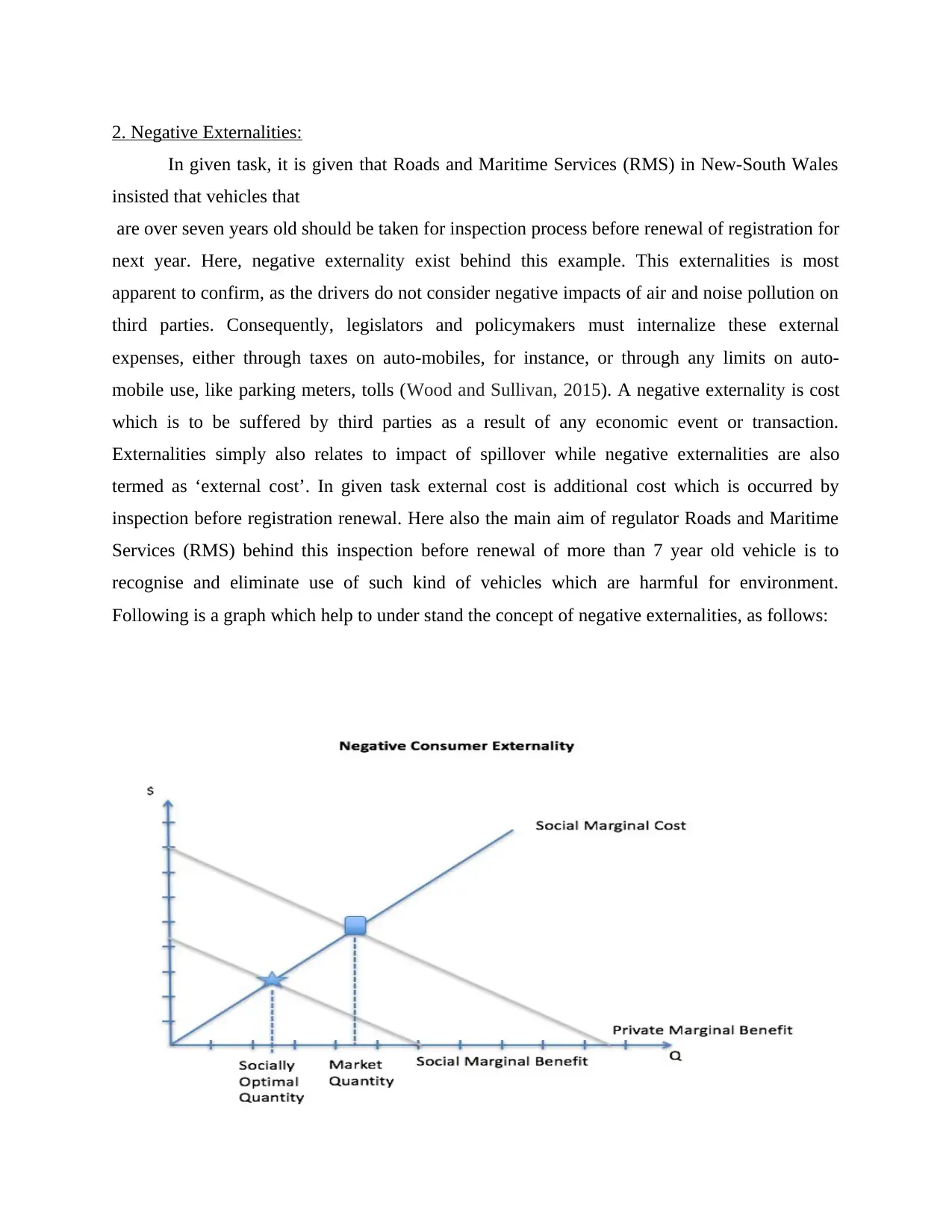
2. Negative Externalities:
In given task, it is given that Roads and Maritime Services (RMS) in New-South Wales
insisted that vehicles that
are over seven years old should be taken for inspection process before renewal of registration for
next year. Here, negative externality exist behind this example. This externalities is most
apparent to confirm, as the drivers do not consider negative impacts of air and noise pollution on
third parties. Consequently, legislators and policymakers must internalize these external
expenses, either through taxes on auto-mobiles, for instance, or through any limits on auto-
mobile use, like parking meters, tolls (Wood and Sullivan, 2015). A negative externality is cost
which is to be suffered by third parties as a result of any economic event or transaction.
Externalities simply also relates to impact of spillover while negative externalities are also
termed as ‘external cost’. In given task external cost is additional cost which is occurred by
inspection before registration renewal. Here also the main aim of regulator Roads and Maritime
Services (RMS) behind this inspection before renewal of more than 7 year old vehicle is to
recognise and eliminate use of such kind of vehicles which are harmful for environment.
Following is a graph which help to under stand the concept of negative externalities, as follows:
In given task, it is given that Roads and Maritime Services (RMS) in New-South Wales
insisted that vehicles that
are over seven years old should be taken for inspection process before renewal of registration for
next year. Here, negative externality exist behind this example. This externalities is most
apparent to confirm, as the drivers do not consider negative impacts of air and noise pollution on
third parties. Consequently, legislators and policymakers must internalize these external
expenses, either through taxes on auto-mobiles, for instance, or through any limits on auto-
mobile use, like parking meters, tolls (Wood and Sullivan, 2015). A negative externality is cost
which is to be suffered by third parties as a result of any economic event or transaction.
Externalities simply also relates to impact of spillover while negative externalities are also
termed as ‘external cost’. In given task external cost is additional cost which is occurred by
inspection before registration renewal. Here also the main aim of regulator Roads and Maritime
Services (RMS) behind this inspection before renewal of more than 7 year old vehicle is to
recognise and eliminate use of such kind of vehicles which are harmful for environment.
Following is a graph which help to under stand the concept of negative externalities, as follows:
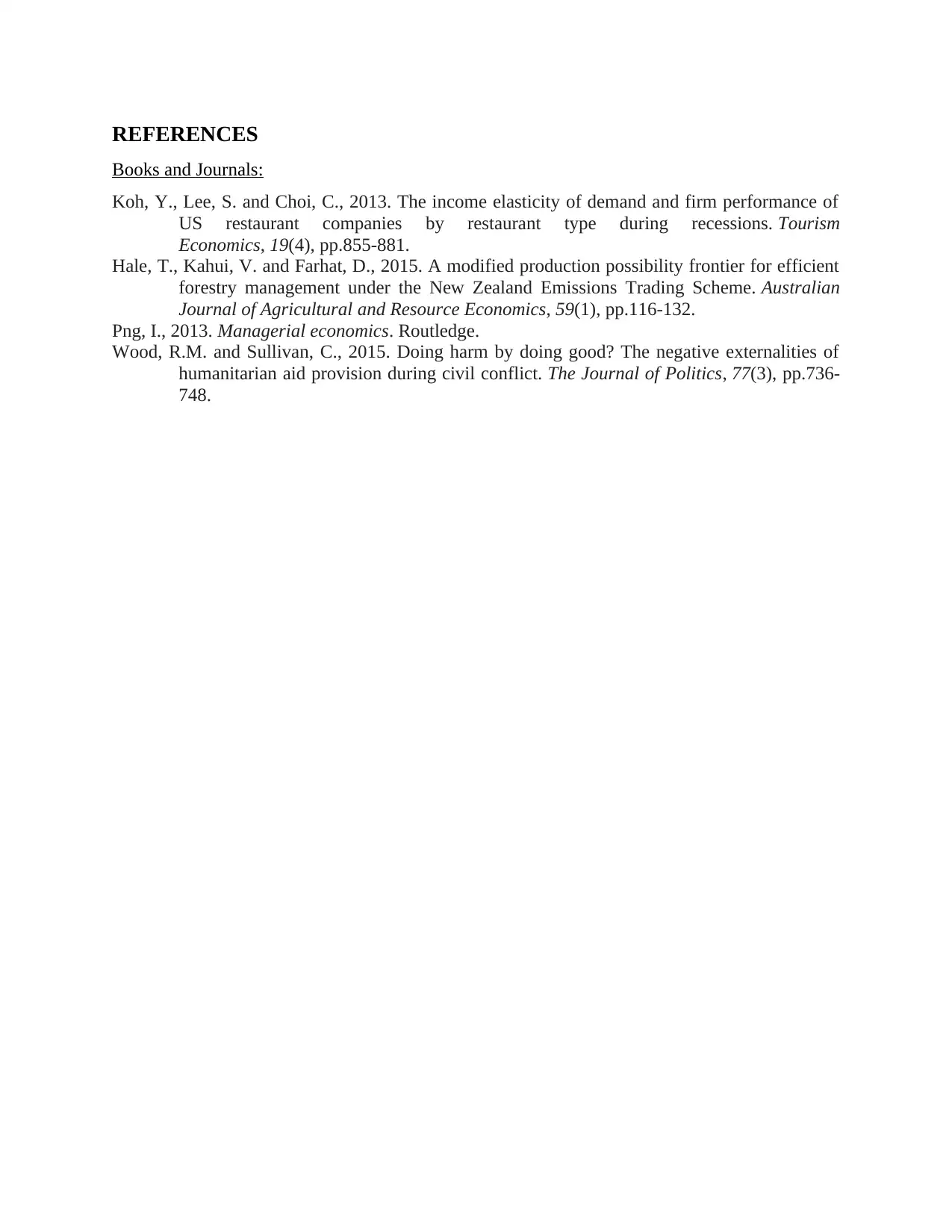
REFERENCES
Books and Journals:
Koh, Y., Lee, S. and Choi, C., 2013. The income elasticity of demand and firm performance of
US restaurant companies by restaurant type during recessions. Tourism
Economics, 19(4), pp.855-881.
Hale, T., Kahui, V. and Farhat, D., 2015. A modified production possibility frontier for efficient
forestry management under the New Zealand Emissions Trading Scheme. Australian
Journal of Agricultural and Resource Economics, 59(1), pp.116-132.
Png, I., 2013. Managerial economics. Routledge.
Wood, R.M. and Sullivan, C., 2015. Doing harm by doing good? The negative externalities of
humanitarian aid provision during civil conflict. The Journal of Politics, 77(3), pp.736-
748.
Books and Journals:
Koh, Y., Lee, S. and Choi, C., 2013. The income elasticity of demand and firm performance of
US restaurant companies by restaurant type during recessions. Tourism
Economics, 19(4), pp.855-881.
Hale, T., Kahui, V. and Farhat, D., 2015. A modified production possibility frontier for efficient
forestry management under the New Zealand Emissions Trading Scheme. Australian
Journal of Agricultural and Resource Economics, 59(1), pp.116-132.
Png, I., 2013. Managerial economics. Routledge.
Wood, R.M. and Sullivan, C., 2015. Doing harm by doing good? The negative externalities of
humanitarian aid provision during civil conflict. The Journal of Politics, 77(3), pp.736-
748.
⊘ This is a preview!⊘
Do you want full access?
Subscribe today to unlock all pages.

Trusted by 1+ million students worldwide
1 out of 9
Related Documents
Your All-in-One AI-Powered Toolkit for Academic Success.
+13062052269
info@desklib.com
Available 24*7 on WhatsApp / Email
![[object Object]](/_next/static/media/star-bottom.7253800d.svg)
Unlock your academic potential
Copyright © 2020–2025 A2Z Services. All Rights Reserved. Developed and managed by ZUCOL.





